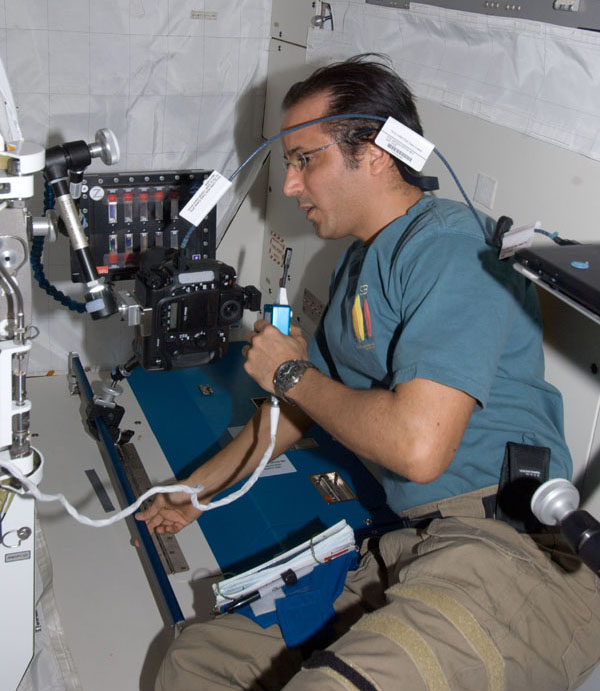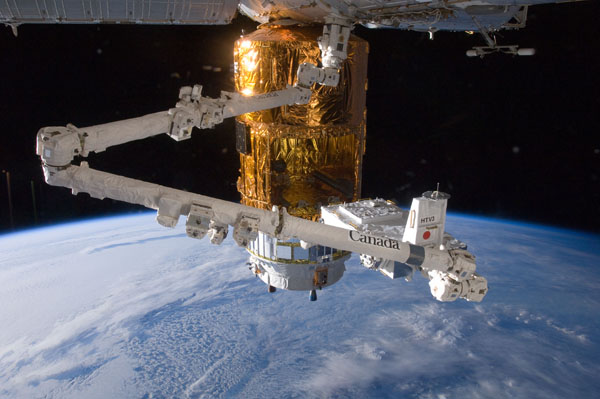The past week sort of defines long duration space fliers.
We certainly don’t do the same thing every day, and every day was different with different types of activities for all of us. There is an awesome group of people on the ground – the planners – who know what all the constraints are for all the activities we need to do. Somehow they make it all work. For example, I had to wear a device that would hinder the use of my left hand for 24 hours, but first I had to fly the robotic arm and work out, and then I had to make sure I had it off in time for me to do a weight lifting exercise the next day. That is just one example of the puzzle these folks on the ground solve every day. We just stick to the schedule up here and somehow it all seems to work. These folks are amazing.

There is a little red line on the computer’s daily schedule which marches across the page with time. So we know if we are ahead or behind schedule. If we are behind, we all seem to pitch in and help each other out to get all of our stuff done. If we are ahead, well that is a good time to take a break, check in with each other, and then see if there is “task list” (extra stuff) we can do. We manage to squeak in taking photos of each other and outside for “historical documentation” (that is from Galaxy Quest but we actually had photo documentation with that name on it for some of our tasks this week – that made me crack up!). But usually by 8pm, we just get dinner ready and relax – no more watching the line after 8pm.
Before bed, lots of science, some operations, some maintenance, and a little relaxing!
Food Frequency Questionnaire
This week instead of having a controlled diet, I just had to write down everything I ate, including the times that I ate them and approximately how much water I drank.
Integrated Cardio Vascular (ICV)
https://www.nasa.gov/mission_pages/station/research/experiments/Integrated_Cardiovascular.html
ICV involves wearing blood pressure cuffs on your fingers – actually really cool technology that can essentially estimate your cardiac output by measuring the blood pressure in your fingers. There is a computer attached to it which puts pressure into the cuff of a finger to counter the blood pressure. So, you get this continuous pressure pulsation on your fingers and the associated motor noise. We wear this for 24 hours and power the pump by Makita drill batteries. They last only about 3 hours, so battery change outs are required during the night.
ICV also involves wearing a holter monitor for 48 hours with Actiwatches. https://www.nasa.gov/mission_pages/station/research/experiments/Actiwatch.html
A holter monitor https://www.nasa.gov/mission_pages/station/research/experiments/Holter.html is a portable device for continuously monitoring various electrical activity of the cardiovascular system. No big deal, just get wired up for a couple days. The biggest issue here is the sticky stuff that holds the electrodes on. After a day – which should involve some exercise – it starts to itch. Maybe I just have sensitive skin, but it seems to leave us red and blotchy at times. Actiwatches are used to sense motion and light. These watches and their data show when we are doing some activity. All three of these devices (blood pressure cuff, holter monitor, Actiwatch) are used together to accurately depict what we are doing to make our heart work.
Bio Rhythms
https://www.nasa.gov/mission_pages/station/research/experiments/Biological_Rhythms_48hrs.html
This is a Japanese experiment that’s also looking at what is going on with us inside and out. This one involved wearing another Actiwatch for motion and light for 72 hours. Then another type of cardiac monitor similar to the holter monitor. This Japanese technology is small, lightweight, and can even be worn in the shower. Pretty reliable! However, I had these experiments one after another this week. It is Sunday night and I am finally free of all the electrodes! I sort of forgot about them – but like I said, working out with all this stuff on gets a little yucky! I was happy to finally get a good wash down of all that sensor sticky stuff this evening – after the Falmouth Road Race!

Reaction Testing
https://www.nasa.gov/mission_pages/station/research/experiments/Reaction_Self_Test.html
Essentially you have a black screen on your computer. You need to hit the space bar as soon as you see numbers counting. I am generally around 200 milliseconds. I was watching swimming and running during the Olympics, and they were talking about the importance of getting a good start at the gun. I think this test can identify who can start quick and who can’t!
Cleopatra and Nefertiti Update
All the doors are open for the fruit flies to come out and be prey to Cleopatra and Nefertiti. Nefertiti is still quite active and eating away. Our little Cleo is still shy…we haven’t seen her. However, for both of them, I fear their destiny. I see next week Joe is tasked with taking them out of the “rack” where we have them stowed – not sure where he is taking them. You know, they don’t need to drink water since they liquefy the fruit flies and use their body water…but I don’t think this can last forever….maybe more to follow.
Second YouTube Space Lab Winners
https://www.nasa.gov/mission_pages/station/main/youtube_space_lab.html
Sara and Dorothy from Troy, Michigan won the 14-16 year-old category. They are just too smart for me. They came up with the idea to test the growth of a type of bacteria, which is used for getting rid of stuff like mold, etc. on plants, which we use for food in space. I think seeing how these bacteria do in space is really cool – especially in light of the landing on Mars. If we do end up growing our own food on the way to Mars, we might need something like this to make sure it remains good during the growth cycle. If the bacteria grows better in space than on Earth, then we might be able to produce it up here. Endless possibilities. These teenage girls are smart!
Binary Colloidal Alloy Test (BCAT)
https://www.nasa.gov/mission_pages/station/research/experiments/BCAT-5-PhaseSep.html
More for Joe!!! He has a lot of patience and very good camera skills. He set up an intervalometer to take pictures of the colloids for 4 days! An intervalometer is a device that counts intervals of time and is used to signal, in accurate time intervals, the operation of some other device. One picture an hour. Science takes time!

Capillary Flow Experiments (CFE VG2)
https://www.nasa.gov/mission_pages/station/research/experiments/CFE-2.html
Watching fluid flow on different surfaces in space. No gravity to hinder the flow, so we are investigating how different surfaces (shapes, perforations, etc.) make fluid flow. Looks just like a lava lamp – but has really great spinoffs for making new types of fuel tanks, for example, for space travel. Pumps can fail – natural phenomena like this won’t for the long trip to Mars!
Burning and Suppression of Solids (BASS)
https://www.nasa.gov/mission_pages/station/research/experiments/BASS.html
More burning stuff in the microgravity glove box! https://www.nasa.gov/mission_pages/station/research/news/msg_anniversary.html We burned a little 2 cm sphere that looked like the sun whizzing through the air. It was bright orange like the sun, with flowing flames behind it – thankfully all contained in the glove box! We also burned different fibrous materials at different airflow speeds to understand how much of that 3rd leg of the fire triangle is needed to sustain a fire. Cool science!
Speaking of fire, we also have a combustion chamber. Joe did work on that to reinstall some very small fuel lines!
Unpacking, Still!
The H-II transfer vehicle (HTV) unpack is almost done! Will be done soon. But in the meantime – we got to load some trash. This place is shaping up and we are getting rid of lots of “common trash.”
Japanese Experiment Module (JEM) Robotics
Joe and Aki used the Japanese robotic arm to “grapple” the HTV – to unload external payloads from the External Platform that HTV brought up. This is such a cool idea! Not everything needs to come inside the ISS. Some experiments and replacement boxes for outside can just stay stored outside. So with the External Platform, we can carry these large things in an unpressurized part of HTV and transfer them to the ISS.

Spacewalk
Getting closer and closer to August 30th when Aki and I will do an EVA. So, we had to start really cleaning out the airlock! Even got to open up our suits and test the “positive pressure relief” system in the suit. Remember, the suits are essentially little space craft so they have all the valves, tanks, cooling, heating, that we have on ISS to keep us alive. These suits haven’t been used for a while, so we are starting to do our “preflight” on them to get them ready!
Exercise
It has been an exhausting week for exercise. Of course we are doing our integrated resistance and aerobic training study (SPRINT) aerobic workouts – which get my heart rate way up there. We are also doing max rep exercises on the advanced resistive exercise device (ARED) now. This is different from last time, because we only lift every other day with this protocol. I was a little wary, but after this week, I think I understand, I need some recovery from this type of workout. I am getting that 2nd day onset muscle soreness with these maximum repetition routine. I like doing a lighter aerobic workout on the lifting days to try to get rid of some of that lactic acid. That seems to help.
Also this week in exercise, I had my Maximum VO2 test. https://www.nasa.gov/mission_pages/station/research/experiments/VO2max.html
Now that isn’t too much fun, I will admit. We are again wired up, and the equipment measures the difference in what you breath in and what you breath out as the exercise intensity increases until you can’t take it anymore. We do this on the cycle ergometer with vibration isolation and stabilization (CEVIS). We have to do this with a nose clip – which is annoying – to make sure they can account for all the air exchange. Of course we are breathing in and out thru a mouthpiece. Lots of mixing bags, hoses, sample catheters, etc. in this contraption…but in the end, I think my VO2 max is pretty good!
Finally, I ran alongside a lot of friends during the Falmouth Road Race in Massachusetts! We tuned into the pre-race festivities through our communication system. I was hoping to wish everyone good luck as well, but we lost communication. However, I started on time (well, 10 minutes late, because of the torrential rain in Falmouth –no rain up here) with the rest of the runners. I finished in around 1:03:52. I had a couple of “water breaks”, but made it thru the 7.2 miles no problem. The first half of the run was my SPRINT protocol and the second was a nice consistent pace until that final “hill” and downhill to the end.
Food:
Had a pesto pasta dinner to go along with the pre-race theme. I had to dig deep to find it in the side dishes container, but I found it! We also have oranges from a Progress 48P delivery. Nothing better than fresh fruit!!!
For pre-race breakfast, something light – I had vegetable quiche. Only need to add hot water and it is ready. Even some bits of broccoli inside – not bad!
Suni’s blog also appears at http://www.fragileoasis.org/bloggernauts/sunita-williams/posts/.
